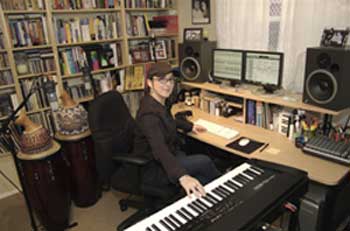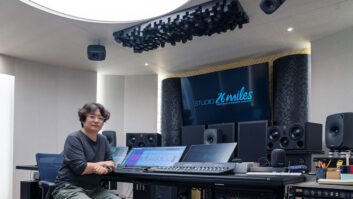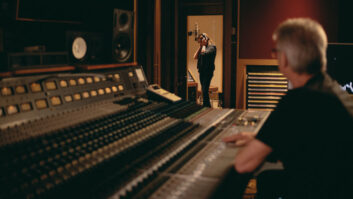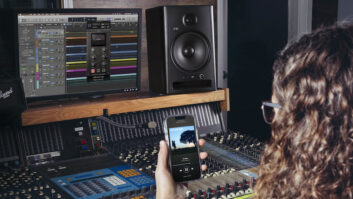
Rebeca Mauleón (www.rebecamauleon.com) has dedicated much of her life and 30-year music career to the study of Afro-Caribbean music, and now is arguably one of the United States’ leading authorities on the subject. In that pursuit, she developed a truly multifaceted career in which she shares her knowledge in numerous ways—as a pianist, vocalist, bandleader, musical director, composer, arranger, producer, clinician, teacher, lecturer, author, journalist and consultant. Mauleón is based in San Francisco but her work frequently takes her on the road in the U.S. and abroad.
The story “Project Studio: Forest Hill Studios” in Mix’s December 2008 issue profiles Mauleón’s home studio, in which she works on music for film, videogames, music software, album projects and more. In this interview, Mauleón expands on her studio work, sharing her particular experiences, insights and approaches to creating and capturing Afro-Caribbean music for a variety of projects.
How do you divide your time between all of the different types of work that you do?
Good question! My trademark as a wearer of many hats seems more and more relevant these days, but honestly, you just make it work. I somehow have found a way to balance the professional life of a musician with motherhood, teaching and everything else. And yet I still manage to get my eight hours of sleep! I also try not to schedule a lot away from home. When I gig out of state—which is more often these days—I try to combine it with some other aspect, such as doing a clinic, even a family vacation.
How did you get started with music technology?
I began in the ’80s when I was an undergrad at Mills College and bought my first Mac along with the first version of [MOTU’s] Performer—before it went digital—and [MOTU’s] Professional Composer. I’ve used Finale [notation software] since it came out.
The learning process was daunting at first, primarily because I detest using manuals! Since I wasn’t too tech savvy early on, the troubleshooting was a bit challenging—how can you troubleshoot something if you don’t know what it’s called? Fortunately I had several tech “gurus” at my beck and call who didn’t seem to mind my frantic phone calls at all hours of the night when I’d hit a wall. Over the years I’ve continued my do-it-yourself approach and relied on colleagues, but I’ve also benefited from the Internet age as far as access to information. I can’t imagine life without Google!
Has your home studio been in the same space all along, or did it begin somewhere else?
I’ve had a project studio in my home for about 20 years or so, beginning in my previous home. It certainly has been re-configured over the years, mainly as gear or software became obsolete or as I found a more streamlined solution to my needs.
I understand that your studio space is a shared multipurpose room, despite its small size.
My husband does video and photo editing there, and my sons play piano and drums. My oldest son plays drums, so most of the time the kit is set up in there as well. I keep a lot of gear in the garage—mic stands, amps, etc.
I also manage several Websites from this computer, so the studio doubles as a home office. Above all else, the studio is also my little sanctuary—I come down here to read, practice, surf the Web, cool off when it gets hot those two or three days a year in San Francisco!
And you’re set up to record other musicians there.
Live tracking usually occurs as a result of a particular commission or pre-production—for example, when I work on mock-ups of the arrangements for a recording, or when I create music for software [companies] such as Electronic Arts and PG Music. I’ve had musicians in here to do vocal overdubs, bass, percussion and horns; in those cases I end up using the nice Avalon preamps.
How do you interface with other studios in terms of file exchanges, and so on?
As far as my collaborative work, one of my partners and I essentially work entirely by file exchanges. When he comes over, it’s usually just for lunch! The work-for-hire pieces are more and more done this way, as well. One of my clients represents a 17-piece salsa band from Korea, and we have evolved into a totally digital work environment. I must say, I don’t miss the days of having to spend hours burning DVDs or snail-mailing hard-drives or scores! Between Apple’s iDisk utility, Fetch, YouSendIt and other file-sharing services, sending and receiving work is a breeze.
Could you tell me about your recent projects?
I recently finished up a batch of music for the Electronic Arts Sims 3 game. The music for Electronic Arts is always a joy to work on. I pretty much get total creative freedom once the stylistic parameters are set. They know my expertise in a variety of “ethnic” music styles, and wanted me to create original music within these genres. The fun part happens when I get to make up nonsensical lyrics to the tunes!
Fortunately for me, I have up to now been able to write music that is not necessarily “wallpaper”; that is to say, it is intended to be listened to! In the Sims, the player will purchase a boom-box or home stereo system as part of their virtual world scenario and actively dial in a “station” where the music will play, so it really is being broadcast to active listeners.
Another recent project was the production of percussion maestro Orestes Vilató’s first solo recording, slated for release in January 2009 on RAFCA Records. The album is entitled It’s About Time, and it was conceived and produced here, then recorded in Los Angeles at two different studios. Orestes and I met for several months in my studio coming up with the repertoire and arrangements, then I created mock-ups for the musicians using MIDI and samples. I also wrote all of the scores and parts, and directed the sessions.
[Vilató’s] album was engineered by Jimmy Branly—a fabulous drummer, as well—and our collaborative relationship on the past few projects is centered on getting Latin music, especially the Cuban percussion, to sound the best it can sound. Jimmy has tremendous ears and knowledge of this music, and we work exceptionally well together as a production team.
Another of my creative partners is Eric Holland. We’ve done several projects together involving world music textures, where I add sampled percussion and other instruments to his sound beds, or sometimes we will de-construct specific world rhythms so he can assign individual parts to completely different instruments. Much of this work goes into documentary film soundtracks, so it often involves a quick turn-around.
I also scored a documentary for MSNBC [Crossing the Line], and I must say this is an area I thoroughly enjoy. Years ago as a Sundance Composer’s Fellow I got to see the inside of the film music biz—we worked with filmmakers, sound editors and composer-mentors, and I realized this was also a passion for me.
When you compose Latin-based music for game developers, which needs to sound authentic as opposed to programmed in order to be believable, how much “realism” do you go for, and how do you achieve it?
My work with Mickey Hart of the Grateful Dead was the most eye-opening in terms of the conceptual aspects of composition. While working with Mickey as musical director of Planet Drum, I began to explore a method of composing in a non-traditional medium, using loops and samples to drive the musical ideas. Now I alternate between this method as well as the more traditional one. Mickey’s live and studio engineer was Tom Flye, and I must say I learned a tremendous amount about recorded sound from both of them.
In my area, the authenticity of Latin music rests on the percussion. If you want something to sound realistic, you’ve got to have the real instruments: the congas, timbales, bongos, batá drums, chékeres, guiro, claves, etc. Granted, there are some samples you can get away with, but the complexities and diverse timbres of these instruments often dictate that you integrate the actual element. Once I’ve created a template of the groove or even the rough form of the piece in Pro Tools, I try to layer in all of my drum and percussion tracks first. I have a nice collection of live percussion samples and loops to choose from. Then I add the bass, keys, pads and other elements with several of the virtual instruments I use.
Horns are another thing you can’t really fake unless you are combining a more synth-driven score with acoustic percussion. For music in software programs, you can often get a good result with some sampled woodwinds, brass, strings and the like, but I always try to blend in a “real player” with the samples to add a realistic feel.
I produced and recorded Santana percussionist Karl Perazzo for PG Music’s Real Drums software. This project consists of multitrack percussion in several Latin music genres that are recorded over a template, allowing the user to “grab” segments of real percussion to integrate into PG Music’s MIDI-based Band-in-a-Box software application. Karl and I have known and worked with each other since we were teens, so it was big fun. We both celebrated our 30-plus years in music recently at the S.F. Jazz Festival! The most important thing this project provides is authentic, human playing with the proper range of sounds, licks, breaks, etc.
With the [PG Music] Real Drums project, everything was real—Karl recorded the congas, timbales, bongos, tambora, guiro, güira, maracas and cowbell, and I overdubbed chékeres, claves, bells and other bits. He only listened to the click on the first pass, then overdubbed to his first track without the click so it would have a more authentic feel. I didn’t have to “correct” anything—he’s such a monster timekeeper! We treated each of the pieces as if it were a tune in live performance, with dynamic changes, breaks and all matter of time-bending fills, exactly the way they would be played in a salsa band and other types of Latin ensembles, as well. The result gives the user the most accurate interpretation of these styles.
What are your plans for the future?
In the months ahead I will be in pre-production for my next solo release, and am also finishing another book in addition to my tour dates. I’m happy to be doing a lot more performing now.
I am very interested in orchestral writing. I’ve written for various types of ensembles, from string quartet and woodwind quintet to big band—and I continue to write and arrange for my own eight-piece band, Afro Kuban Fusion—but I would love to do an orchestral score. I will also continue producing other artists’ work—this is something people are requesting more often. Of course, I’m happy with whatever the next opportunity brings!







